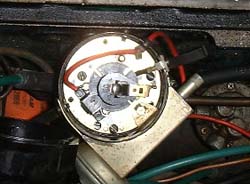Spitfire Cam Timing
In the time that I've owned my Spitfire, the engine has always
failed to rev to its full potential - always feeling to be down on power. Since a
're-build' - necessitated by one of the exhaust valves falling into the combustion camber
(ouch!) - the situation has moved from bad to worse...
Question is: Why?
Been struggling with the ignition timing, carburettor tuning, fuel
pressure, and so so much more that I was beginning to think that an engine transplant was
going to be THE best way forward... At the same time though, I felt that the Mk3 high
compression (HE) engine had so much character, it would be a shame to loose it if all that
was wrong was something fundamental and simple that neither I nor any other expert I had
consulted would have expected...
... which leads us to the cam timing. A friend had just had a head
porting and new cams installed in his K-series engined MGF. Performance was okay, but not
as good as might have been expected for the kind of work done. So I joined him for a trip
to David Andrew's garage in Milton Keynes (he really is the Vizard of K-series tuning).
The problem turned out to be cam timing. Properly timed, the cams now gave my friend's car
a whole new fresh leash of life. A valuable lesson was learnt regarding engine tuning that
day. A lesson that brought me round to wondering what exactly the timing on my Triumph's
cam was...
As it turned out, the cam wheel on a Triumph four cylinder is quite
unusual in that it is bolted into position with 4 equally spaced bolts. This means that it
is surprisingly easy to bolt the cam sprocket in the wrong position - and in fact this
appears to be intentional, as it allows the cam to be timed. Bolt it on 90 degrees out,
and the timing is quarter of a tooth out. Reverse the cam, without bolting it 90 degrees
out of phase, and you get half tooth difference in timing. Reverse the cam, and bolt it 90
degrees out, and you get three-quarters of a tooth out. As there are 21 teeth, each tooth
is 360/21 = 17.1 degrees.
So was the cam timing out on my Spitfire?
The cam timing was checked using the method cited by Carter Shore on
the Totally Triumph Network Forum:
Checking the camshaft timing at the
valves; the Spitfire's cam profile and timing are symmetrical, and so valve clearance for
cylinder #1 intake and exhaust will be equal at TDC.
| 1 |
Remove spark plugs and valve cover.
Pictured opposite are the spark
plugs as removed from my car's engine. As you can see, the first 2 spark plugs are
actually rather sooty, whilst the latter 2 are slightly paler... This indicates that I
have a problem with carburettor #1. |
| 2 |
Rotate motor until #8 valve is fully open.
Adjust clearance on #1 valve to .040" [I actually set the clearance to 0.075" so
it was easier to tell when the clearances at valves 1 & 2 were equal - 0.017" as
it turned out] |
| 3 |
Rotate motor until #7 valve is fully open.
Adjust clearance on #2 valve to .040" [as above, actually set at 0.075"] |
| 4 |
Rotate motor until clearance on #1 and #2 is equal (#1 just closing, #2 just
opening). This is called the balance point.
I've put a feeler gauge in to show
that valves 1 and 2 had the same clearance. |
| 5 |
The crank pulley should be at top-dead
centre (TDC).
Well, that's the theory. Pictured opposite
is what I saw at the balance point. White paint shows the timing mark on the crankshaft
pulley. Oh dear. I measured that distance between the timing mark and the marker for TDC.
29mm. The crankshaft pulley is approximately 118mm in diameter. That's a radius of 59mm.
Using a bit of trigonometry, that equates
to 28.5 degrees out...!!!
Hmm, looks as though I need to strip off
the timing chain cover, and measure all this out a little more accurately, but either way,
it seems that the cam timing is out! |
 |
One other thing that I did notice though - that was the
distributor's rotor arm position. I was expecting this to be pointing towards #1 lead, but
in fact was pointing at #4 (pictured opposite). So either I am confused (not for the first
time with my car!!!) or the distributor is 180 degrees out.
D'oh!